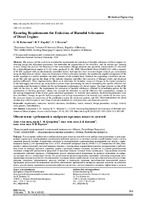| dc.contributor.author | Kuharonak, G. M. | |
| dc.contributor.author | Kapskiy, D. V. | |
| dc.contributor.author | Berezun, V. I. | |
| dc.coverage.spatial | Минск | ru |
| dc.date.accessioned | 2020-08-04T07:23:15Z | |
| dc.date.available | 2020-08-04T07:23:15Z | |
| dc.date.issued | 2020 | |
| dc.identifier.citation | Kuharonak, G. M. Ensuring Requirements for Emissions of Harmful Substances of Diesel Engines = Обеспечение требований к выбросам вредных веществ дизелей / G. M. Kuharonak, D. V. Kapskiy, V. I. Berezun // Наука и техника. – 2020. – № 4. – С. 305-310. | ru |
| dc.identifier.uri | https://rep.bntu.by/handle/data/77404 | |
| dc.description.abstract | The purpose of this work is to consider the requirements for emissions of harmful substances of diesel engines by selecting design and adjustment parameters that determine the organization of the workflow, and the exhaust gas cleaning system, taking into account the reduction of fuel consumption. Design elements and geometric characteristics of structures for a turbocharged diesel engine of Д-245 series produced by JSC HMC Minsk Motor Plant (4ЧН11/12.5) with a capacity of 90 kW equipped with an electronically controlled battery fuel injection have been developed: exhaust gas recirculation along the high pressure circuit, shape and dimensions of the combustion chamber, the number and angular arrangement of the nozzle openings in a nozzle atomizer, and inlet channels of the cylinder head. Methods for organizing a workflow are proposed that take into account the shape of the indicator diagrams and affect the emissions of nitrogen oxides and dispersed particles differently. Their implementation allows us to determine the boundary ranges of changes in the control parameters of the fuel supply and exhaust gas recirculation systems when determining the area of minimizing the specific effective fuel consumption and the range of studies for the environmental performance of a diesel engine. The paper presents results of the study on the ways to meet the requirements for emissions of harmful substances, obtained by considering options for the organization of working processes, taking into account the reduction in specific effective fuel consumption, changes in the average temperature of the exhaust gases and diesel equipment. To evaluate these methods, the following indicators have been identified: changes in specific fuel consumption and average temperature of the toxicity cycle relative to the base cycle, the necessary degree of conversion of the purification system for dispersed particles and NOx. Recommendations are given on choosing a diesel engine to meet Stage 4 emission standards for nitrogen oxides and dispersed particles. | ru |
| dc.language.iso | en | ru |
| dc.publisher | БНТУ | ru |
| dc.title | Ensuring Requirements for Emissions of Harmful Substances of Diesel Engines | ru |
| dc.title.alternative | Обеспечение требований к выбросам вредных веществ дизелей | ru |
| dc.type | Article | ru |
| dc.identifier.doi | 10.21122/2227-1031-2020-19-4-305-310 | |
| local.description.annotation | Рассмотрены требования к выбросам вредных веществ дизелей путем выбора конструктивных и регулировочных параметров, определяющих организацию рабочего процесса, и системы очистки отработавших газов с учетом снижения расхода топлива. Разработаны элементы и геометрические характеристики конструкций для дизеля с турбонаддувом серии Д-245 производства ОАО «УКХ «Минский моторный завод» (4ЧН11/12,5) мощностью 90 кВт, оснащенного аккумуляторной системой впрыска топлива с электронным управлением (система рециркуляции отработавших газов по контуру высокого давления, форма и размеры камеры сгорания, количество и угловое расположение сопловых отверстий распылителя форсунки и впускные каналы головки блока цилиндров). Предложены способы организации рабочего процесса, учитывающие форму индикаторной диаграммы, по-разному влияющие на выбросы оксидов азота и дисперсных частиц. Их реализация позволяет определить граничные диапазоны изменения регулировочных параметров систем топливоподачи и рециркуляции отработавших газов при определении области минимизации удельного эффективного расхода топлива и диапазона изучения экологических показателей дизеля. Приведены результаты исследования способов обеспечения требований к выбросам вредных веществ, полученные путем рассмотрения вариантов организации рабочих процессов с учетом снижения удельного эффективного расхода топлива, изменения средней температуры отработавших газов и комплектации дизеля. Для оценки этих способов выделены показатели: изменение удельного расхода топлива и средней температуры цикла токсичности по отношению к базовому циклу, необходимая степень конверсии системы очистки по дисперсным частицам и NOx. Даны рекомендации по выбору комплектации дизеля для обеспечения норм Stage 4 по выбросам оксидов азота и дисперсных частиц. | ru |

